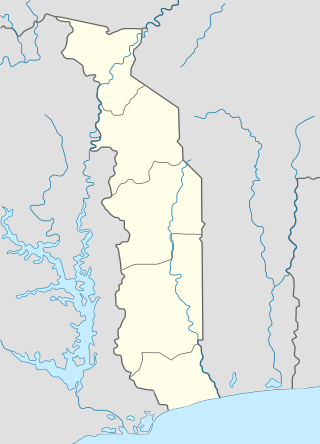Kpalimé
| Kpalimé | |
|---|---|
 |
|
| Location in Togo | |
| Coordinates: 6°54′N 0°38′E / 6.900°N 0.633°E | |
| Country | Togo |
| Region | Plateaux Region |
| Population (2010) | |
| • Total | 75,084 |
Kpalimé is a city in the Plateaux Region of Togo, 120 km north of Lomé and 15 km from the Ghanaian border. It is the administrative capital of Kloto Prefecture. Kpalimé has a population of 75,084, making it the fourth-biggest town in Togo, after Lomé, Sokodé and Kara. The town has a cathedral, a scientific lycée, and a post-office, as well as several banks, medical centres, pharmacies, cyber-cafés and petrol stations.
Kpalimé was originally called Agomé-Kpalimé, being one of the villages of the Agomé people. Their origins can probably be traced to Yorubaland in modern Nigeria, and in particular to two cities: Ifè (the religious center) and Oyo (the political and administrative center). Migrants gradually moved west, settling in Kétou (Benin), Tado (Togo), and eventually founding the town of Notsé.
King Agokoli, who ruled Notsé in the early 18th century, was a tyrant. This caused many people to flee, taking refuge in Gamé. There were three main groups of fugitives, one of which was made up of Agomé, Agou, Kpélé, Danyi, Gbi, Peki, Kpando, Matsè and Wodzo people.
Their migration eventually led them to Anidi on Mount Kloto (then named Méléku), which is located 13 km north west of Kpalimé. The Agomé consisted of five clans led by a chief called Tsali. There, they were free to practice activities such as agriculture, hunting, farming, fishing, crafts and trade.
However, it was common for tensions to break out among migrants on their arrival in a new location, and the Agomé were no exception. They quarreled over a goat's head, and since the conflict could not be resolved to everyone's satisfaction, some of the elders decided to leave Anidi and go and live on the plain.
The first group went to live on the lower slopes of the mountain, in a place where the trees were called "Yoti", hence the name Agomé-Yo. The second group settled on a rise at the foot of the Kouma Plateau. This became known as Agomé-Kpodzi. The third group settled in a place they named Agomé-Koussountou. The fourth group crossed the river and founded Agomé-Tomégbé. The fifth group moved to "Mokpalipé", meaning crossroads, and the pronunciation gradually evolved into "Kpalime".
...
Wikipedia

